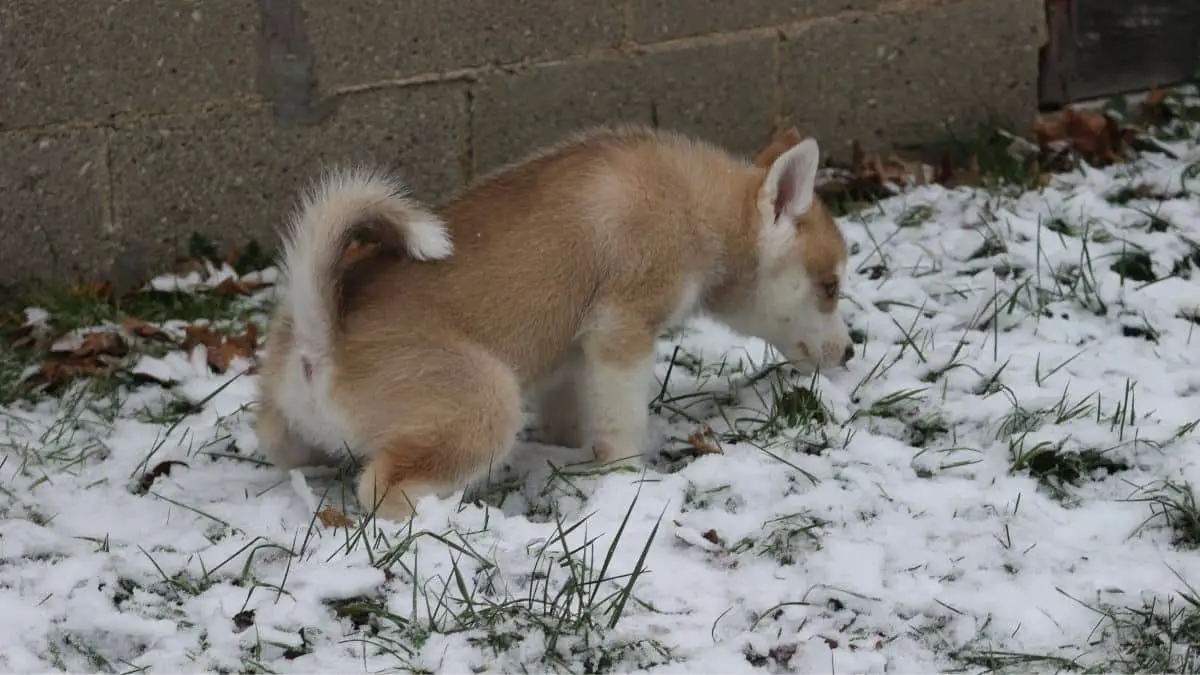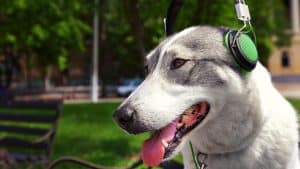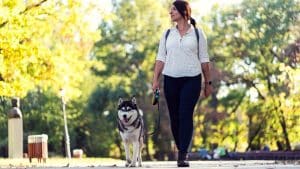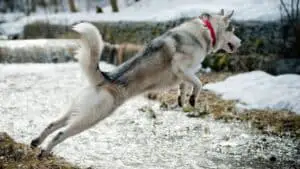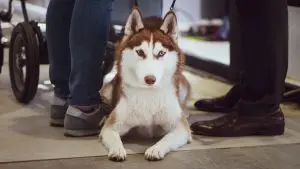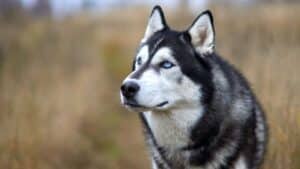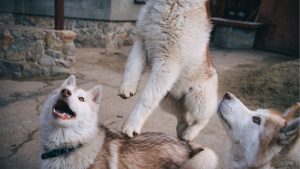Siberian Husky Potty Training (Easy Step-by-Step Guide)
Arguably one of the most important tasks in the life of a Husky owner is house training or potty training. Teaching your Husky puppy (or even an adult dog) to do his business correctly is key to a long and happy relationship between the two of you. Luckily, puppy potty training is a relatively straightforward task, as long as you are armed with lots of patience and plenty of treats!
Establishing a proper training process is critical to the long term success of your potty training endeavors. Potty training Huskies is no different in principle to any other type of training – you will need to be firm, consistent, and use plenty of positive reinforcement.
Potty training your puppy will require time, so don’t get impatient and become tempted to rush the process. Your Husky’s natural stubbornness may be daunting at first, but remember that no matter how stubborn (or how old!) your pup is, he can be potty trained. The most important thing is to not give up on the training and become inconsistent, or you risk setting back weeks of hard work!
Table of Contents
The Practical Bit: How To Potty Train A Husky
As with any type of training, consistency and positive reinforcement are the two most critical weapons in your training arsenal. Your Siberian will be much more likely to develop good bathroom habits if he is regularly rewarded for these habits. Your dog is a creature of habit – make sure those habits are the right ones!
Husky puppy owners, listen up. It is also much easier to instill the correct behaviors in your puppies while they are still young. It is of course not impossible to train an older dog, but you will save hours of time if you start early, and start young.
It is also important to remember that any sign of hostility toward your Siberian, no matter their age, may set back any progress that has been made. Huskies do not respond well to yelling and shouting. You must remain calm and consistent in your training. While an accident inside the house is something no dog owner ever wants to deal with, inevitably accidents happen.
So with those ground rules in place, let’s get into it!
Housetraining: key steps
The specifics of your potty training process will depend upon your living situation and the individual characteristics of your dog. For example, if you live in an apartment with an older Husky, you will have a slightly different routine to an owner that lives in a house with a yard and a young puppy.
Whatever the specifics of your situation may be, a few key principles will remain the same.
1. Establish a firm routine
Establishing and maintaining a firm morning and night time schedule will go a long way to the successful housebreaking of your pup. This includes feeding your dog or puppy at the same time every day, monitoring their access to water throughout the day, and regularly scheduling vigorous playtime.
One of the most important parts of this schedule is regularly taking your puppy outside to their potty spot so that they can learn that this is the best and most correct way to do their business.
2. Take regular trips outside
If you want to live without a life of accidents from your furry friend, you will need to show them the correct environment for them to do their business in. By taking your pup outside at regular, key intervals, they will begin to learn that the urge to go to the bathroom is always accompanied by a trip outdoors to nature!
Some key times that you should be taking your dog outside include:
- After he has eaten
- After he has had something to drink
- After he has woken up (first thing in the morning or after a nap)
- After playtime
- Before they go to sleep
3. Be positive!
Once you have established your routine and are sticking to it, you’ll need to show your puppy that good habits are always rewarded!
Begin by giving him tasty treats, praise, or pats whenever he goes correctly. He will begin to associate this reward with going to the bathroom and will begin to do so of his own volition after a while. This positive reinforcement with treats is a highly effective and efficient way to teach your pup good behaviors.
However, if your dog does have toileting accidents, don’t get angry or upset. Instead, immediately take him outside to his usual spot, wait until he goes again, and then reward him with some mouth-watering food! He will soon get the picture!
Some key tips and pointers
During this puppy training period, the trainer should always be around, or around as much as possible. If you need to be away from home for any length of time, crate training can be a helpful method of avoiding soiling accidents, as your pup is unlikely to do his business in his crate.
However, it is important to know that you shouldn’t crate your young dog for too long. A young puppy has little control over his bladder, and may not be able to hold it for too long. A good rule of thumb for knowing how long your puppy will be able to hold it for is knowing that his age in months equals the strength of his bladder in hours. For example, by the time your puppy reaches his 4th month, he can hold his bladder for around 4 hours.
If you do not use a crate, or if you are an apartment dweller, you could also use puppy pads. Puppy training pads can give you peace of mind in any situation in which you aren’t able to take your puppy outside as regularly as you might like.
Once you have your processes down pat and the basic steps are almost second nature to both you and your Husky, you might want to start observing his behavior around bathroom time. Being able to pick up on the signs that your dog is about to urgently need the toilet is a key complement to your initial training endeavors. This is a process in which you are working together – there will be far less stress involved if you are able to act as a team!
Common Mistakes While You Potty Train Your Husky
You should always expect some mistakes during the potty training period. When this happens, keep calm and simply take your puppy outside and clean up the mess. It is important that you clean up every last bit of poop and pee, as dogs will tend towards the same ‘bathroom spot’ every time – you certainly don’t want this to be on your carpet!
Remember that if your puppy – or even your older dog – decides to use the ‘inside toilet’, it’s not really his fault. As long as you are consistent with your training the vast majority of the time, and don’t allow it to become a pattern of behavior, these accidents are simple one-offs that are easily avoided in the future.
As with most aspects of dog ownership, properly training your Siberian to be house trained requires time, patience, and consistency. If you are able to dedicate yourself to providing these three things to your dog during the potty training process, you will find the results very gratifying!
What To Consider When Potty Train Older Huskies?
While most guides are dedicated to house training puppies, there are sadly many instances in which older dogs need this same training. Whether you’ve picked up your adult dog from a shelter, or adopted him from a friend or family member, some older dogs that were not given the correct instruction in their early years may not know how to toilet themselves properly.
The good news is, the process for training puppies and training older dogs is virtually identical. While you may have a few ingrained habits that need breaking in your older dog, you also have the benefit of his larger bladder capacity!
When it comes to training older dogs, it sometimes seems as though some bad habits are insurmountable. However, with time, patience, and plenty of positive reinforcement, there is no reason that your efforts with your older dog won’t pay off.
Your Pup’s Potty Training – The Final Word
Although it is an important aspect of training your furry friend, don’t let it become a source of anxiety for either of you. If you are able to create and stick to a solid routine from the outset, and are committed to working together with you Husky – not against him! – this particular training exercise can be relatively simple and painless.
Hopefully, if you have committed to bringing a dog of any breed into your home, you have also committed to ensuring that your dog’s life is as long and as happy as possible. Both your canine and your carpets will thank you in the long run for overcoming the initial difficulty and challenge that potty training presents. And always remember – you’ll get much further with fun than with fear!

